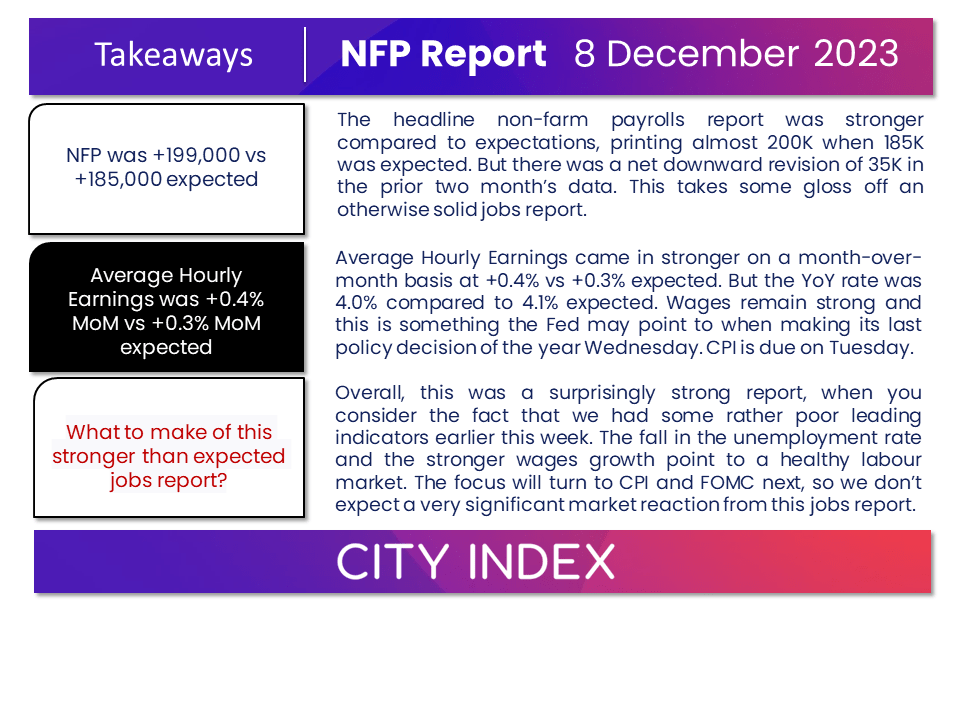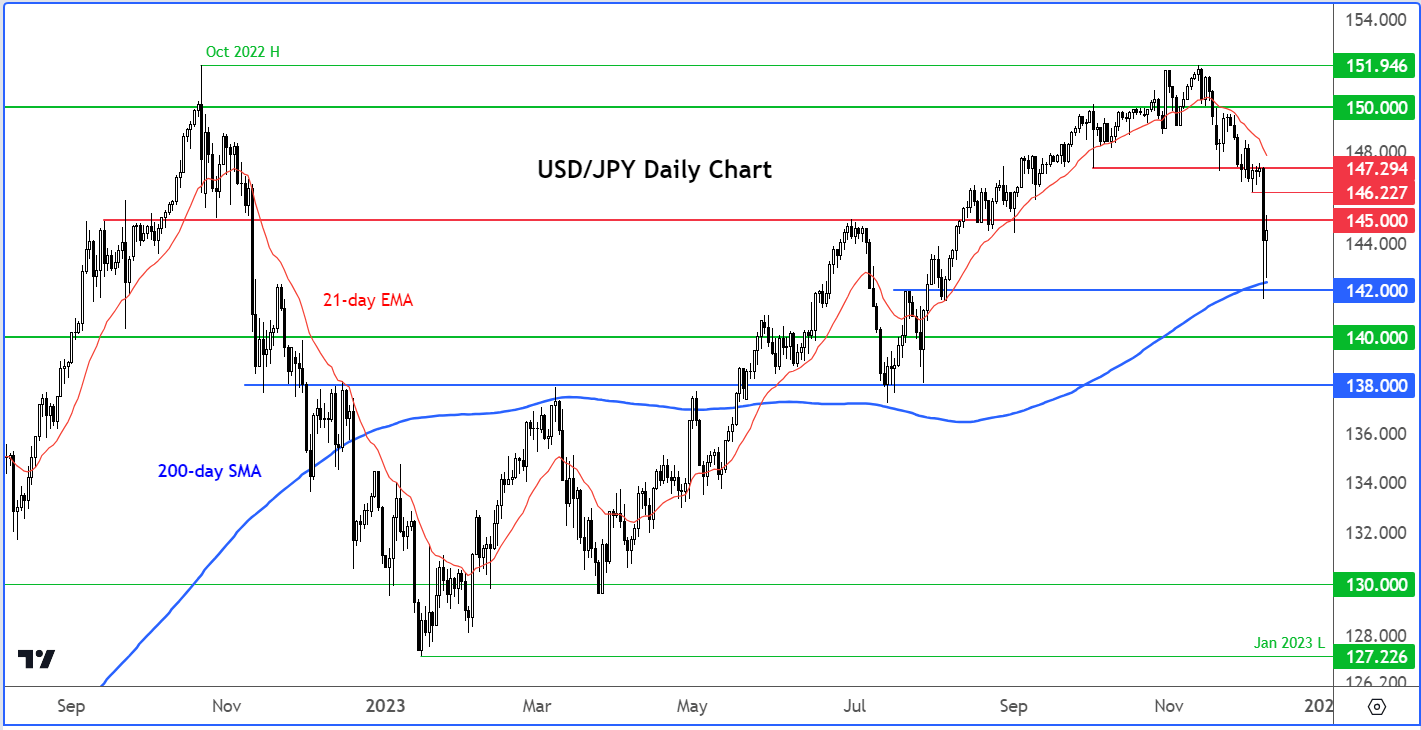USD/JPY analysis: NFP beats expectations, but will it arrest the USD/JPY drop? NFP printed almost 200K vs. 185K expected, with average earnin
- USD/JPY analysis: NFP beats expectations, but will it arrest the USD/JPY drop?
- NFP printed almost 200K vs. 185K expected, with average earnings and u/e rate also beating
- Looking ahead to next week: US CPI, FOMC, BOE, ECB and SNB all on the horizon
Welcome to another edition of Forex Friday, a weekly report in which we highlight selected currency themes. In this week’s edition, we will discuss the US dollar in light of the NFP beat, and ahead of next week’s key macro events.
NFP beats expectations
The US jobs report was published earlier, beating expectations. The markets moved in the way you would expect in terms of immediate reaction, with the dollar and bond yields rising across the board, while gold and indices fell somewhat. Shortly afterwards, some of these moves were typically unwinding. The already-volatile USD/JPY rose to above 145.20 in initial response, before falling to as low as 143.76, before returning to its pre-NFP levels. The USD/JPY will remain in focus with investors anticipating a potential policy shift from the BoJ. Other major FX pairs endured less volatility in terms of immediate reaction to the jobs report. Gold and silver were holding onto their losses at the time of writing.
Before discussing what today’s jobs report means for the markets and look ahead to the big events next week, here’s a summary of today’s non-farm payrolls report:

Today’s stronger-than-expected jobs report is somewhat surprising, given the overall weaker indications we have had earlier this week from other labour market pointers.
Earlier this week, we had seen a softer than forecast ADP payrolls figure, while the JOLTS job openings had also suggested that the official employment report would perhaps be significantly weaker than expected. The 4-week moving average of initial unemployment claims rose to 221K, up from last month’s 213K reading, and the employment component of the ISM manufacturing PMI had slipped to 45.8, while that of the services PMI had hardly improved to 50.7. So, already, the market was probably positioned to see a disappointment.
Well, as it turned out, those pre-NFP indications were not so correct, with the ADP yet again proving to be a poor indicator of the official jobs report. Little wonder why it was totally ignored it on Wednesday, when the dollar rose.
Ahead of today’s publication of the NFP report, the US dollar was higher earlier on Friday against most major currencies bar the Canadian dollar and was making back a chunk of its losses against the yen following the latter’s sharp rally on Thursday. Investors were taking a more cautious approach, with NFP being the start of the last major macro events left for this year. Next week, the focus will be on US CPI on Tuesday, which, along with today’s NFP data, could very well influence the Fed’s decision in terms of what to signal in terms of next year’s expected rate cuts.
In light of today’s stronger data, the market will be wondering whether they will hear any form of confirmation from the Fed that rate cuts could start at the end of Q1 or start of Q2 next year, after all. Perhaps, the upcoming CPI report could determine how hawkish or dovish the Fed will be on Wednesday.
USD/JPY analysis: key levels to watch
Following the stronger US jobs report, the USDJPY rose, then fell, before bouncing back. The key level to watch is around 145.00. For as long as it remains below this level, the path of least resistance will remain to the downside in light of the big breakdown on Thursday. Above that level, the next resistance is seen around 146.20ish. Key support is seen at 142.00, where we have the 200-day average residing. Below it, the next major psychological barrier is at 140.00.

Source: TradingView.com
Looking ahead to next week: US CPI, FOMC, BOE, ECB and SNB all on the horizon
US CPI
Tuesday, December 12
13:30 GMT
Next week’s key event could well be the inflation report on Tuesday, overshadowing the expected rate hold at the FOMC meeting a day later. If inflation fails to ease quickly, it could delay expectations of the Fed’s first cut. A flat CPI and a decline in core CPI last month increased bets on a Q1 cut, supporting US indices and weakening the US dollar. The possibility of the Fed signalling cuts at the upcoming meeting is debatable, but early signs of deflation could prompt a major reaction in the markets, even if the Fed adopts a cautious approach the next day.
FOMC meeting
Wednesday, December 13
19:00 GMT
This is the final Fed meeting of 2023, which means the FOMC will present its staff projections, the dot plots, as well as the usual statement and then a press conference with Chairman Jerome Powell. Fed Fund futures currently imply almost 100% chance of the Fed holding rates. A notable recent shift is the change in expectations for the Fed’s initial rate cut, moving from May to March, although those expectations changed a little after a stronger jobs report on Friday. Current pricing indicates around 50% likelihood of a cut, so a coin flip. Given the forward-looking nature of markets and weaknesses in certain sectors of the US economy, anticipating cuts in the first half of next year is not entirely unfounded but a lot will depend on that CPI report.
BOE, ECB and SNB meetings
Thursday, December 14
08:30 to 13:15 GMT
The three major central banks in Europe are expected to keep their policies unchanged on Thursday. The BOE has indicated a prolonged hold on the current rate, and the ECB has recently paused, with market expectations ruling out another hike. Consistently weak economic data has seen traders anticipate an ECB rate cut next year, lifting the DAX to reach fresh record highs. Similar to the Fed, a slightly dovish tone from the ECB is likely needed to justify the repricing for cuts. However, if the ECB doesn’t signal such a move next week, this may support the euro and exert some downward pressure on the DAX.
Video analysis: USD/JPY, GBP/USD, Gold, FTSE and Nasdaq
— Content created by Fawad Razaqzada, Market Analyst
Follow Fawad on Twitter @Trader_F_R
How to trade with City Index
You can trade with City Index by following these four easy steps:
-
Open an account, or log in if you’re already a customer
• Open an account in the UK
• Open an account in Australia
• Open an account in Singapore - Search for the company you want to trade in our award-winning platform
- Choose your position and size, and your stop and limit levels
- Place the trade
www.cityindex.com

COMMENTS